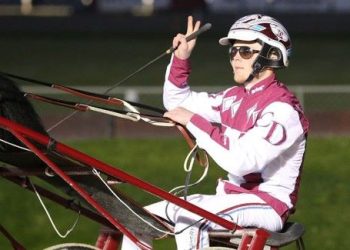He was the A. J. Foyt of the harness racing world. During a 10-year career, Dan Patch broke records and raked in prize winnings. His appearance at events drew fans by the thousands. Through it all, he never lost a race.
Sportswriter Charles Leerhsen calls Dan Patch “the most celebrated American sports figure in the first decade of the 20th century, as popular in his day as any athlete who has ever lived.”
Leerhsen is the author of “Crazy Good: The True Story of Dan Patch, the Most Famous Horse in America” (Simon & Schuster). The book, published in 2008, is testament to Dan Patch’s reputation. Though few sports fans today recognize the Dan Patch name, his legend lives on in books, a movie and in the town of Oxford, Indiana where the mahogany-colored pacer was born in 1896.
Visit Oxford on a Saturday morning and you’ll find oldtimers gathered for coffee at the Dan Patch Café. The water tower proclaims, “Home of Dan Patch.” On the first weekend following Labor Day, the Lions Club sponsors Dan Patch Days, a festival featuring basketball and euchre tournaments, a car show and baby contest.
Raised by Daniel Messner Jr., Dan Patch began life as a knobby-kneed colt that could hardly stand to nurse. With perseverance, Messner raised him to be a pacer and entered him in his first harness race in Boswell, Indiana, winning the mile in 2:16.
Mention horse racing, and most Americans think thoroughbreds and the Kentucky Derby. Dan Patch was a standardbred, and his jockey rode behind him in a two-wheeled cart called a sulky.
After experiencing success in Indiana, Messner contacted a New York horse trainer to prepare Dan Patch for the 1901 Grand Circuit, harness racing’s top events nationwide. He raced in Detroit, Cleveland, Columbus, Buffalo and Brighton Beach, N.Y., among other cities. His 12 straight wins that year netted $13,800 in prize money.
In 1902, Messner sold Dan Patch to M.E. Sturgis of New York City for $20,000, an unheard-of sum at the time. Sturgis turned around and sold the horse for $60,000 to Marion W. Savage, owner of the International Stock Food Company of Minneapolis.
By this point, other stables refused to race Dan Patch because of virtually certain defeat, but he continued to build his legend by endorsing commercial products and by racing against the clock.
In Lexington he ran the mile in a record 1 minute, 55.25 seconds in 1905. The following year he clocked 1:55 during an exhibition at the Minnesota State Fair. The new record did not become official because the sulky used a dirt shield, which was not allowed, but Savage took full advantage of the moment. He renamed his farm the International 1:55 Stock Food Farm.
Dan Patch retired to be a stud in 1909. Horse and owner died in 1916, but they weren’t forgotten.
The United States Harness Writers Association still gives out the Dan Patch Awards. The Hoosier Park Racing & Casino in Anderson is located on Dan Patch Circle, and the park’s feature race for pacers is the Dan Patch Invitational.
It’s not known where Dan Patch was buried. Horse fans often stop to pay respects at a headstone and historical marker on the east edge of Oxford where the farm where he was raised still proclaims his unofficial record on the side of the barn.
Note to readers: This is the 66th of 100 essays on Indiana history leading to the celebration of the Indiana Bicentennial in December 2016. Neal is a teacher at St. Richard’s Episcopal School in Indianapolis and adjunct scholar with the Indiana Policy Review Foundation. Contact her at aneal@inpolicy.org.
Directions: The Dan Patch historical marker is at 203 S. Michigan Rd. near the intersection of SR 352 & SR 55 in Oxford.
By Andrea Neal
Reprinted with permission of the greensburgdailynews.com site

 USA
USA Canada
Canada Australia
Australia New Zealand
New Zealand Europe
Europe UK / IRE
UK / IRE


